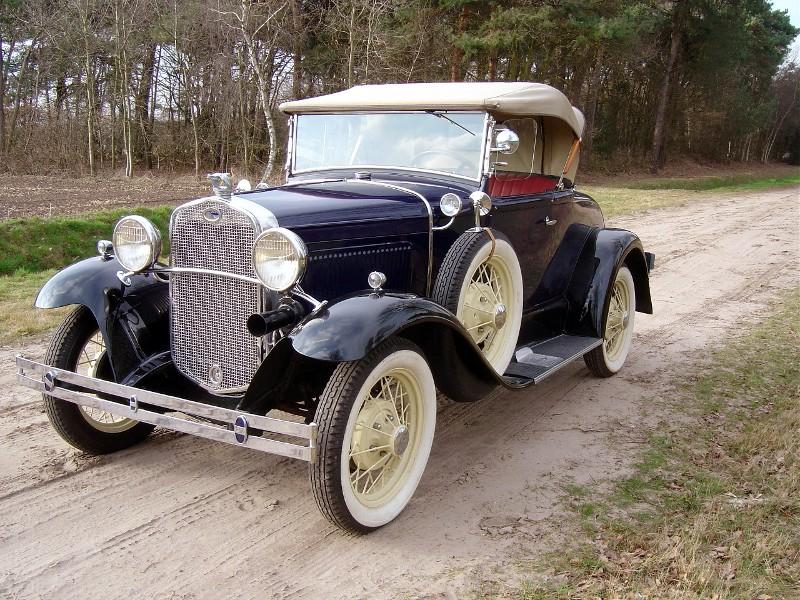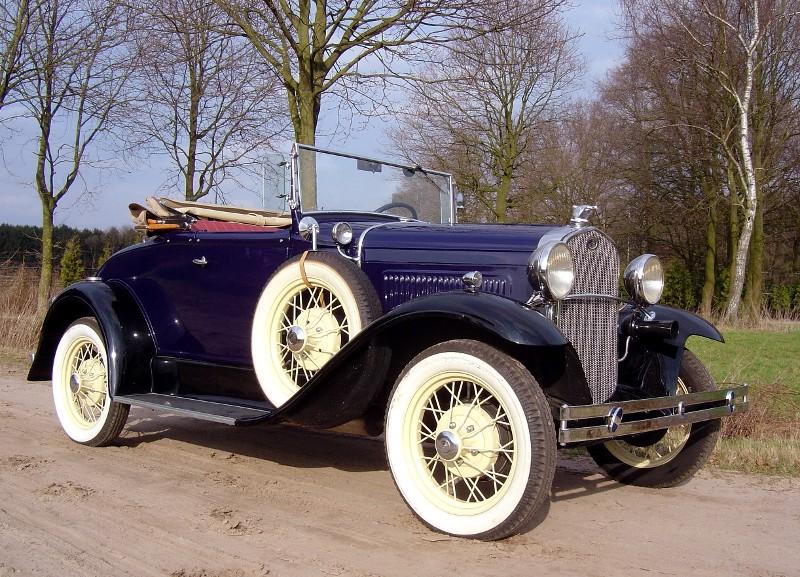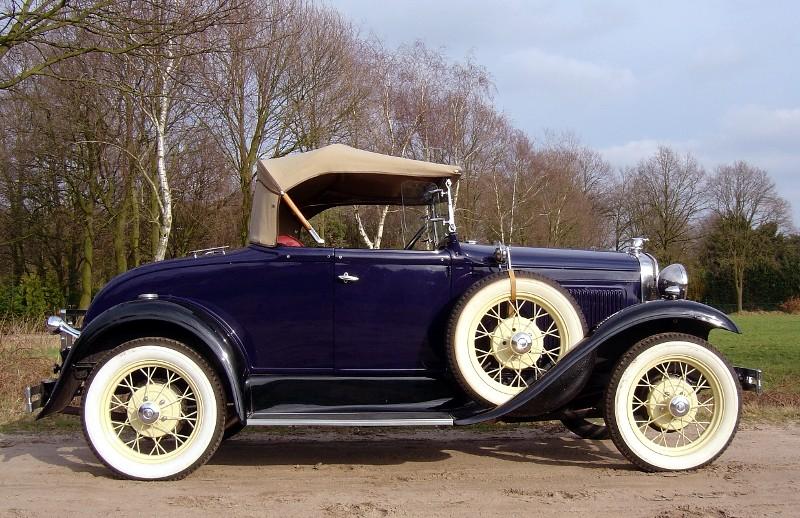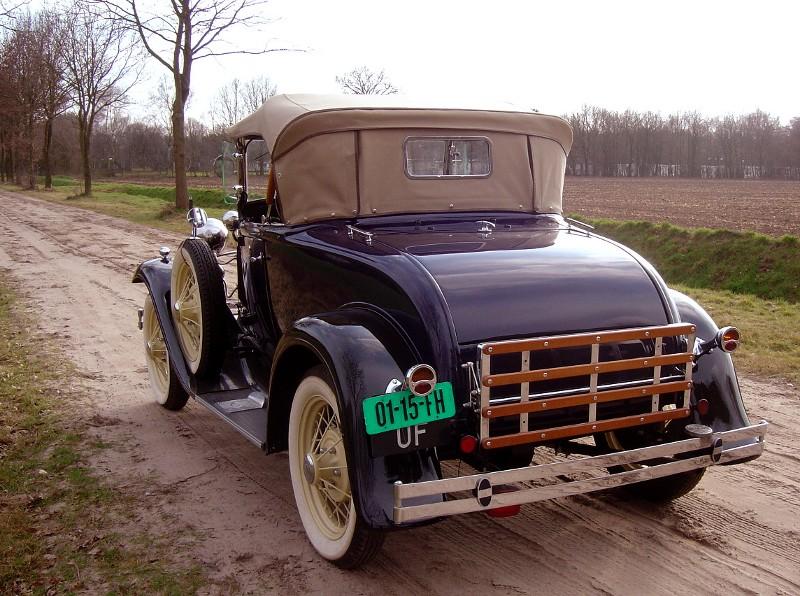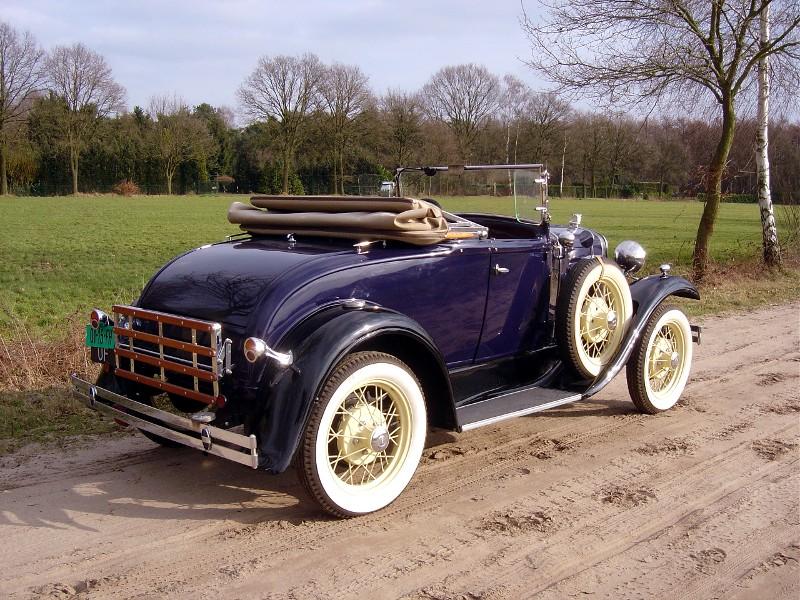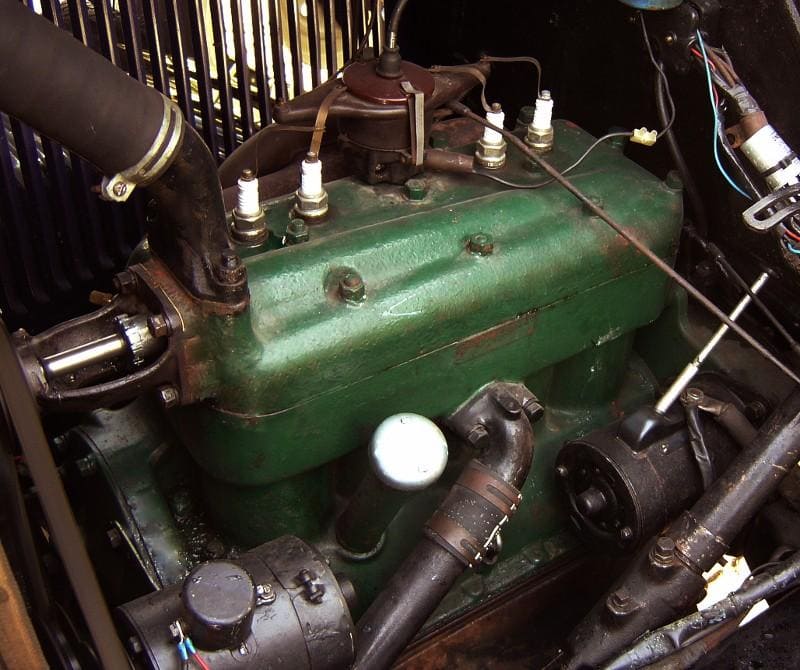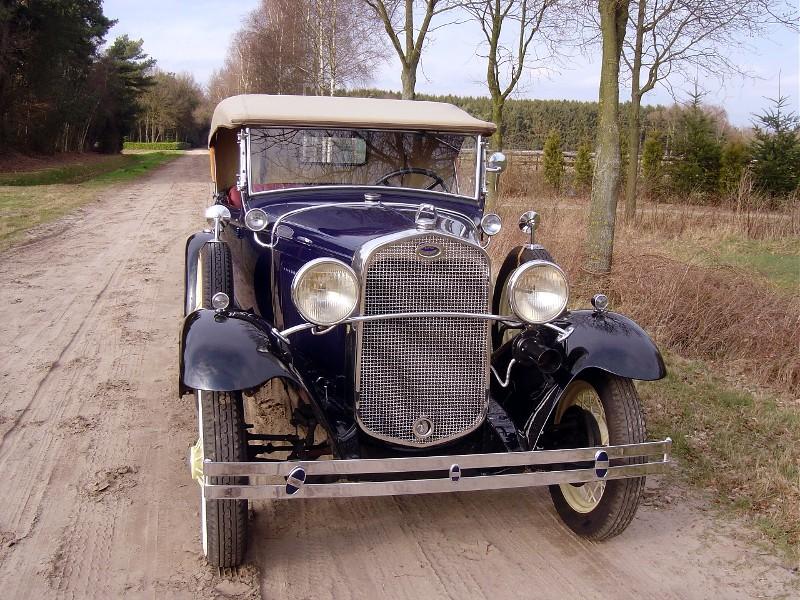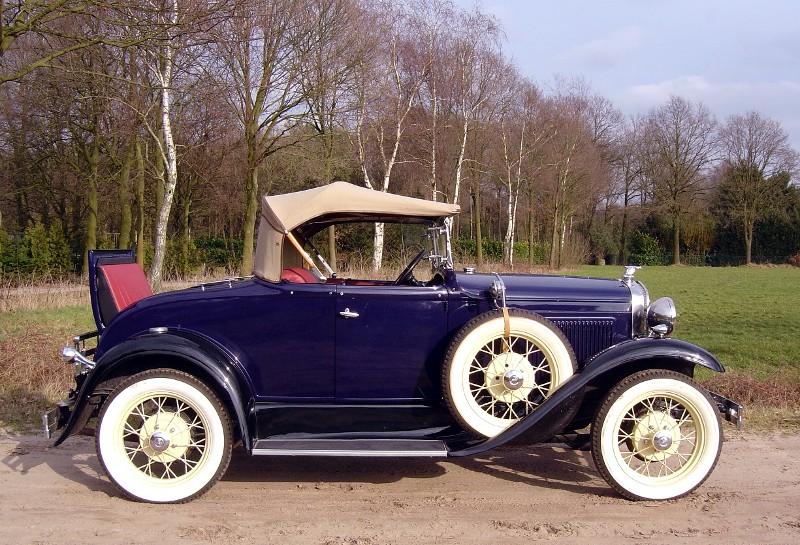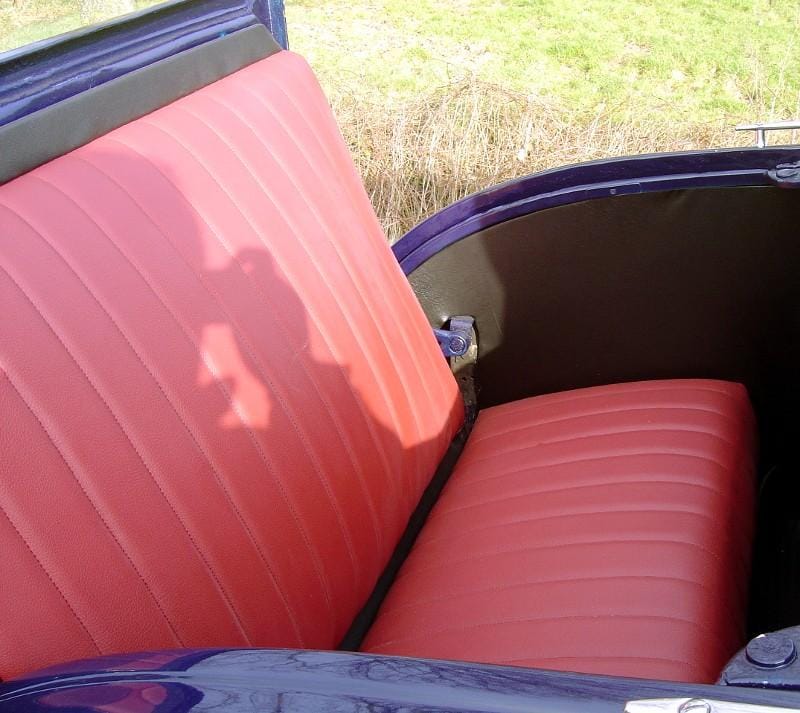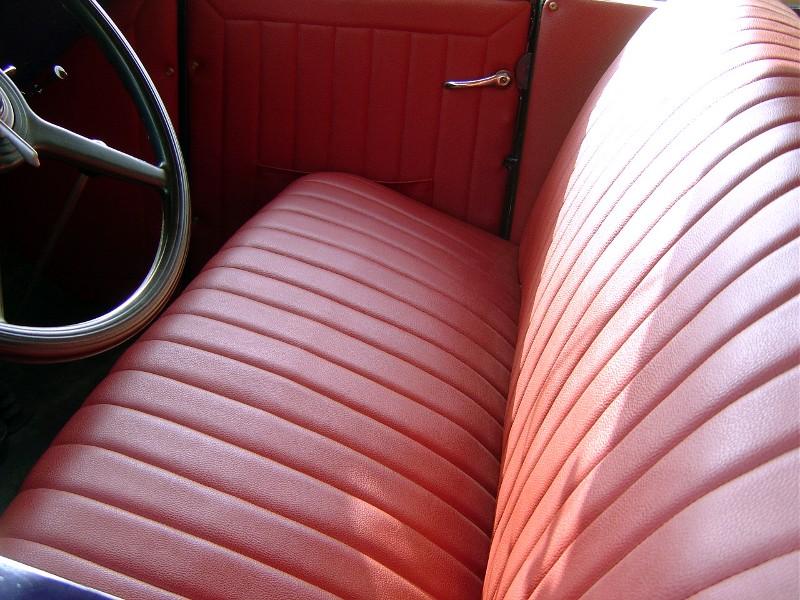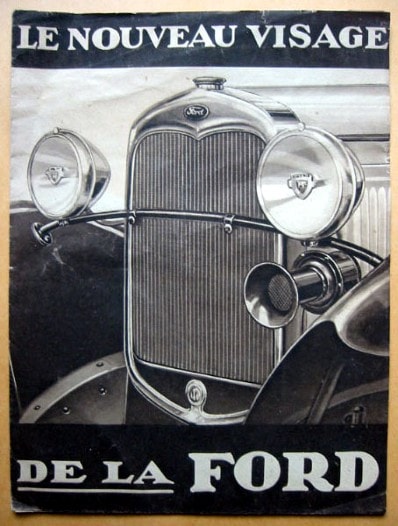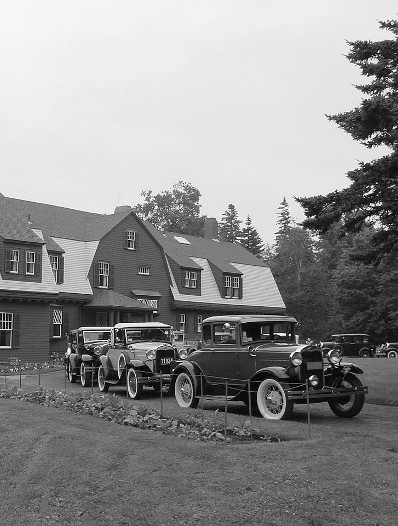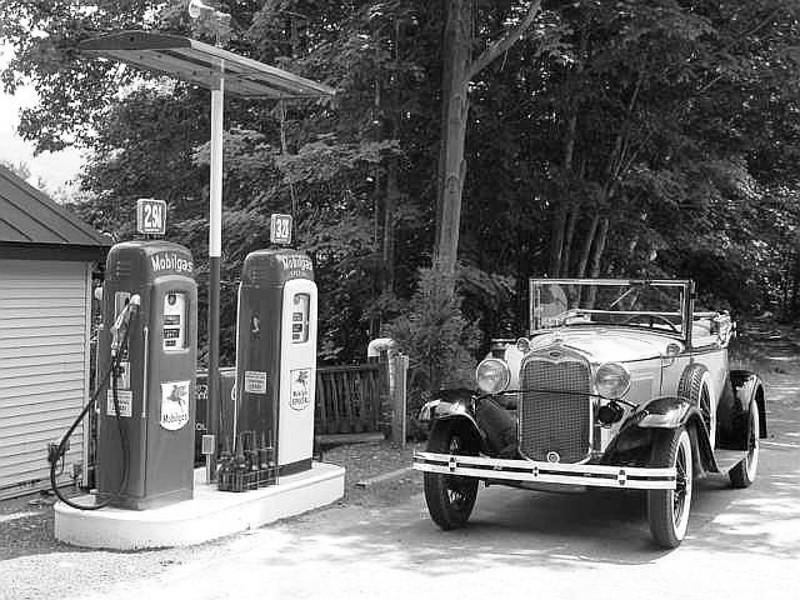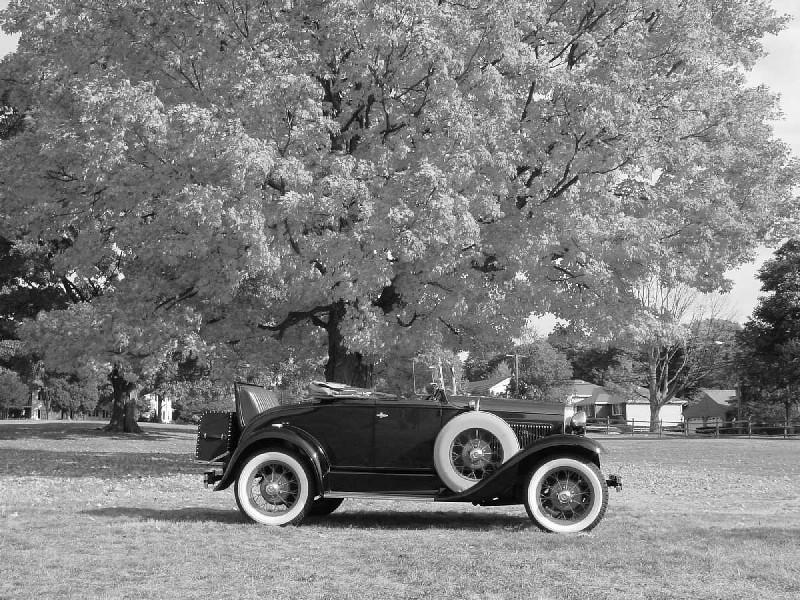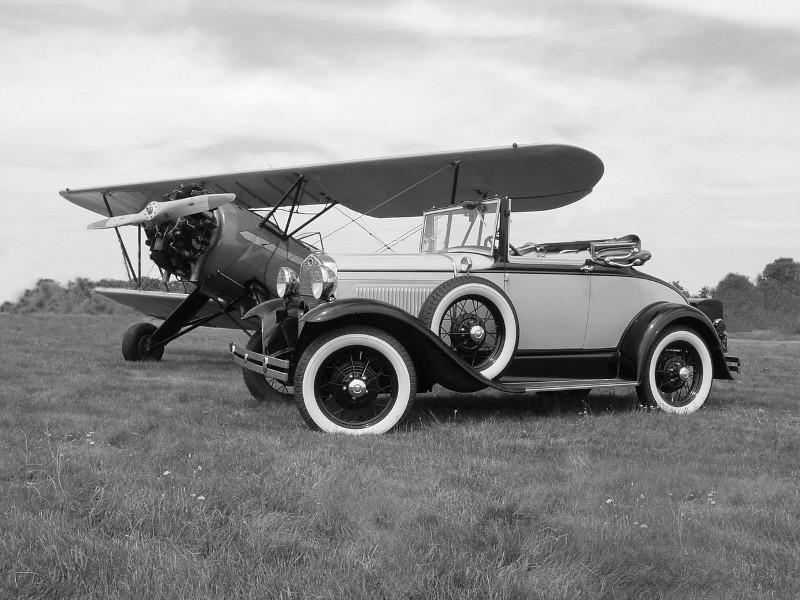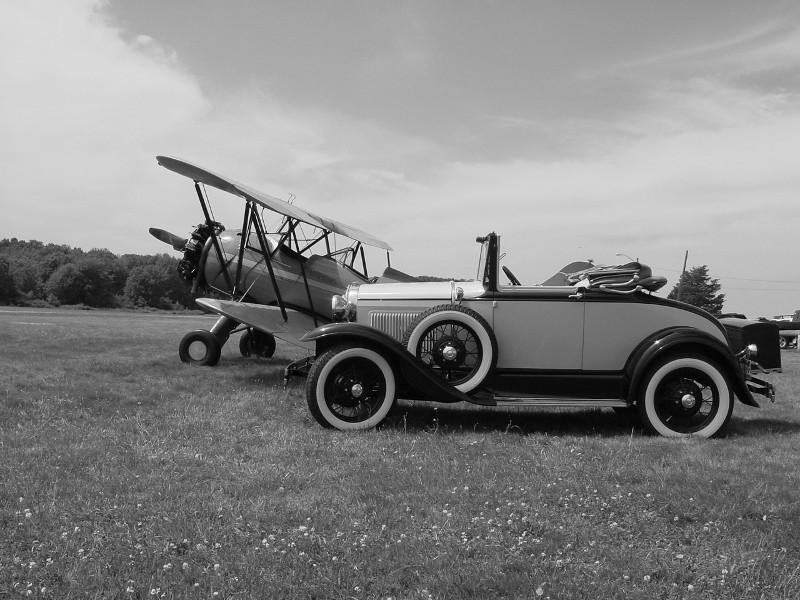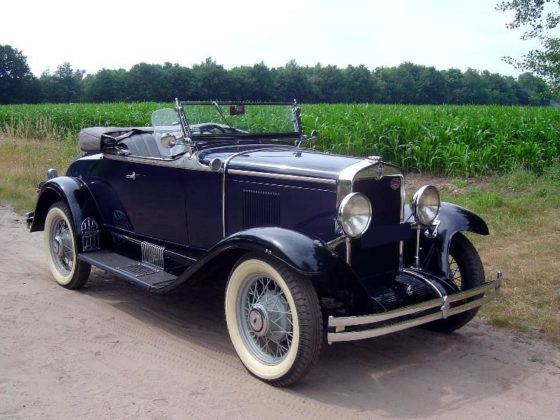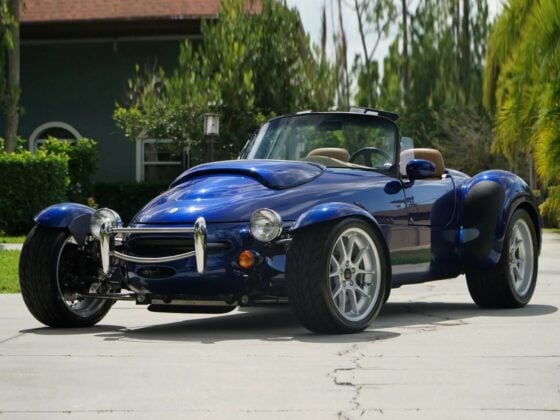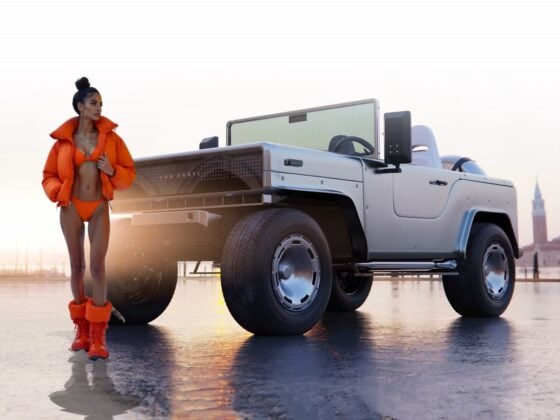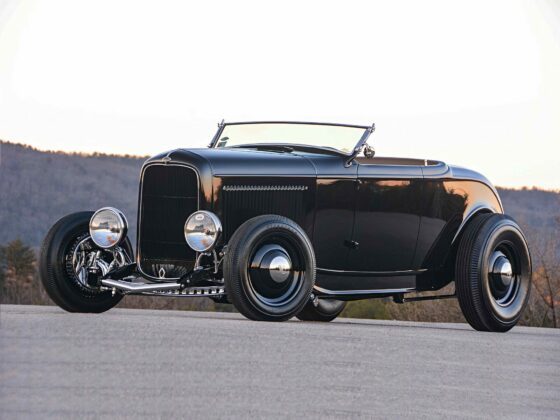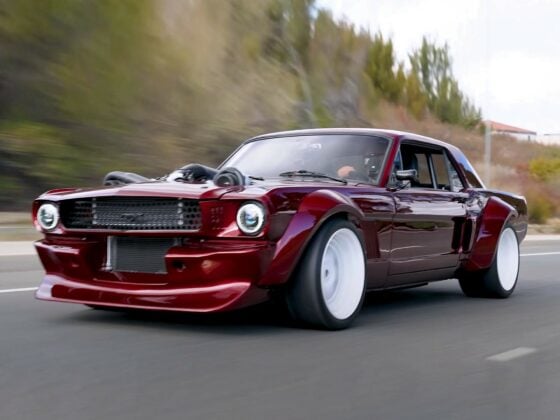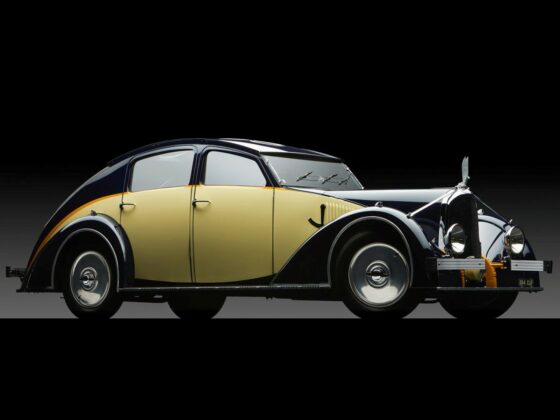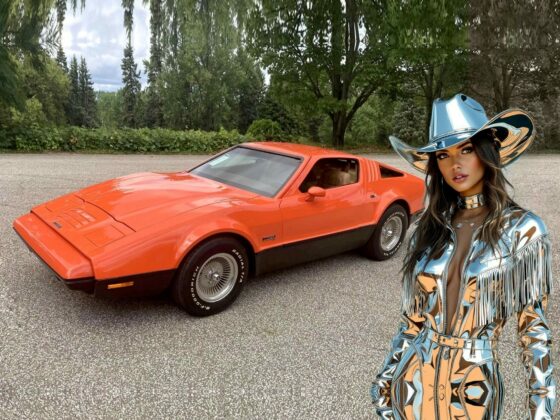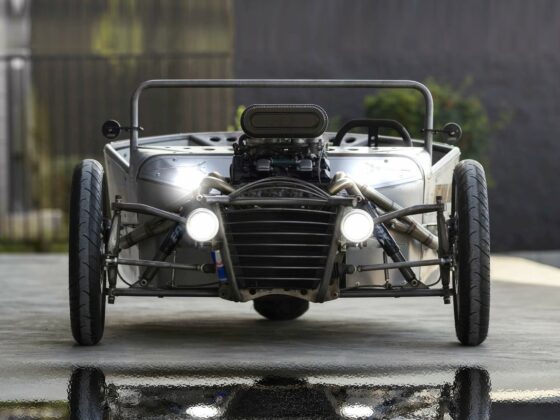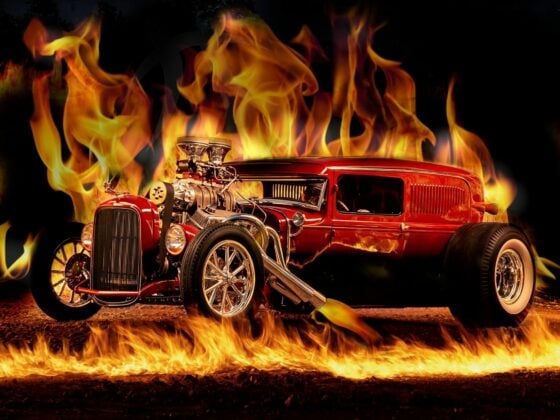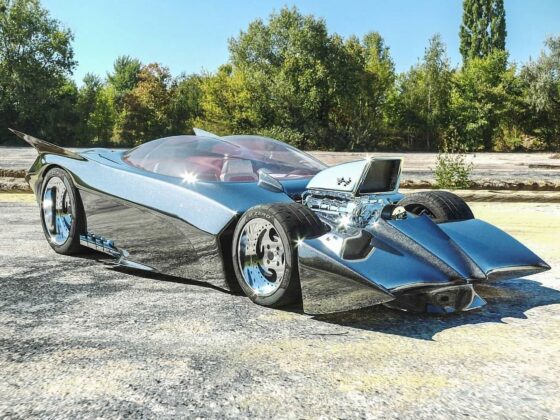1930 Ford “A” Roadster “Deluxe” two-passenger…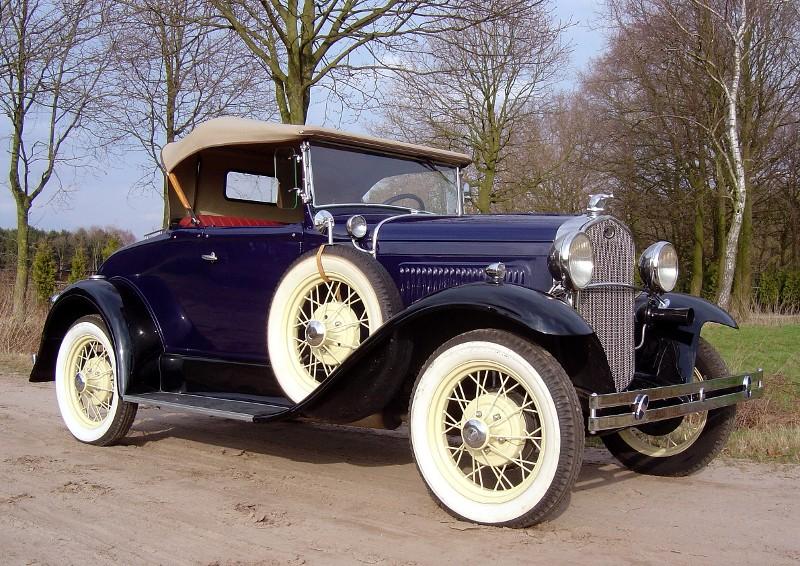

Henry Ford est probablement l’un des hommes qui ont le plus influencé l’industrie automobile mondiale en la faisant passer du stade artisanal et luxueux des temps héroïques au stade industriel.
Père de l’assemblage à la chaîne, il a permis la démocratisation de l’automobile.
Mais Henry Ford avait une vision globale du marché et accordait des salaires élevés à ses ouvriers pour qu’ils puissent s’acheter des voitures.
Né dans une ferme dans une banlieue rurale de Detroit, son père était Irlandais et sa mère d’origine Belge.
Il ne sut jamais écrire ou parler de manière aisée.
Il a toujours été passionné par la mécanique et en premier par les montres après avoir démonté et remonté une montre reçue de son père.
A 15 ans il avait la réputation d’être déjà un horloger expérimenté.
Il démonta ensuite entièrement une des premières autos à essence avant de se faire engager chez Edison à Detroit en 1890 tout en continuant ses travaux personnels dans son garage.
En 1893, il passa ingénieur chez Edison
En 1896 il parvint à construire sa première voiture automobile.
Malgré le soutien de Thomas Edison, ses activités automobiles finirent par entrer bientôt en conflit avec sa carrière chez Edison et il dut en partir pour fonder la Détroit Automobile Company, dont il se sépara trois ans plus tard, déçu de la mauvaise qualté et du prix des voitures fabriquées, pour construire des voitures de course avec un ami.
L’une de ces autos, la “999“, remporta une course et lança la carrière de Ford dans l’industrie automobile.
La Detroit Automobile Company continua sa route sous le nom de Cadillac Automobile Company.
Le 16 juin 1903 Henry Ford fonda la Ford Motor Company (ou FoMoCo), avec un capital de 150.000 dollars (dont 28.000 dollars de sa poche) avec 10 autres actionnaires, dont les frères Dodge.
Progressivement il rachèta les parts de tous ses associés, il en devint Président en 1906 avec 59% des actions et se trouva seul maître en 1919.
L’usine fut installée dans une ancienne fabrique de fiacres de Detroit, elle connut des débuts difficiles.
Mais Henry Ford fourmillait d’idées : en 5 ans, il créa 19 modèles différents.
Le succès vint en le 12 août 1908 avec l’arrivée de la célèbre Ford T.
Elle sera vendue à plus de 15 millions d’exemplaires partout dans le monde.
La Ford T était une voiture simple à construire, à conduire et surtout à réparer, construite à la chaîne avec moins de 5.000 pièces.
Il y en a eu près de 16 millions et demi de produites.
Les usines Ford étaient déjà intégrées, recevant les matières premières et sortant des autos finies.
La Ford T apportait un certain nombre d’innovations marquantes, comme un volant sur la gauche, bien plus pratique pour conduire sur la droite de la chaussée, ce que toutes les autres compagnies copièrent immédiatement.
La voiture était fournie complète avec moteur et transmission, le moteur quatre cylindres lui-même était coulé d’un seul bloc.
Son prix de $825 en 1908 était si faible (et il baissait chaque année) que dans les années 20 on pouvait dire que la majorité des américains avait appris à conduire sur une Ford T.
En 1914, Ford révolutionna le monde de l’industrie en offrant un salaire de $5 par jour à ses ouviers, soit deux fois plus que tous ses concurrents.
Cette politique de l’emploi attira les meilleurs professionnels et les retint chez Ford.
Le succès de la Ford T fut tel que la demande dépassa l’offre.
Ford n’eut même pas besoin de faire de publicité de 1917 à 1923 pour vendre ses Ford T !
Pour produire la Ford T, Henry Ford a du mettre en place une nouvelle méthode de travail appelée “le fordisme” inspirée directement du taylorisme, lui-même nommé OST (organisation scientifique du travail), qui se répandra rapidement au sein de l’ensemble des industries de transformation.
Pour faire face à une relative saturation du marché résultant d’une diffusion très large de la Ford T, Henry Ford élabora le principe du renouvellement des versions pour ses automobiles.
De nouvelles versions de la Ford T apparurent, parfois avec des modifications mineures par rapport aux versions précédentes, de sorte que le marché était régulièrement stimulé par cet effet de mode.
Le succès du Modèle T permit à Ford de s’agrandir considérablement aux États-Unis, mais également en Asie (1909), en Amérique du Sud (1910), en Europe (1911) et en Australie (1925), ou de nouveaux sites de production et d’assemblage virent le jour.
Ce développement fulgurant s’accompagnait d’un système de rémunération unique pour l’époque : 5 dollars pour 8 heures de travail par jour en 1914.
Pendant la Première Guerre mondiale, Ford produisit des sous-marins, des chars, des avions et des ambulances pour les alliés.
La société se lança par la suite dans la production de camions et de tracteurs (Fordson) en 1917.
Suivra la production aéronautique en 1925 (avion Tri-Motor), malheureusement stoppée par la dépression économique qui sévira aux États-Unis après la crise de 1929.
En 1919, Henry Ford prit sa retraite et transmit les pouvoirs à son unique fils, Edsel, tout en continuant à s’intéresser de très près à la société.
Le 1er janvier 1925, Ford sortit sa 10 millionième voiture.
En 1927 Ford décida de remplacer la mythique Ford T et lança la Ford A, une quatre cylindres de 3,3 litres, à soupapes latérales, avec une boîte trois vitesses, des freins sur les quatre roues, une robe imitée de celle de la Lincoln (firme dirigée par Ford depuis 1922)… et pour la première fois d’un pare-brise incassable en série.
Malgré la crise, quatre millions d’exemplaires furent vendus en quatre ans.
Ford s’implanta ensuite de manière plus importante en Europe, notamment à Dagenham, Angleterre, en 1929 puis à Cologne, Allemagne, en 1930.
Ces deux sites deviendront les quartiers généraux de Ford Europe.
En 1932, Ford sera le premier constructeur à commercialiser un V8.
Le 18 janvier 1937, Ford sortit sa 25 millionième voiture…
Dans les années 1910, Henry Ford a même expérimenté l’emploi de matériaux agricoles dans la fabrication de ses automobiles.
Ford était en partie motivé par le désir de trouver des demandes non alimentaires pour les excédents agricoles, qui existaient déjà alors comme aujourd’hui.
Il a essayé beaucoup de ressources agricoles, y compris le blé.
Les boîtiers de protection du ressort de démarrage pour les Ford T modèle 1915 ont été fabriqués à partir d’une résine de gluten de blé renforcée avec des fibres d’amiante.
Par la suite, il s’est concentré sur le soja et, dans les années 20, il a commencé à promouvoir les produits de soja en chaque occasion.
Il a recruté Robert Boyer, un jeune chimiste, pour mener la recherche.
Dans les années suivantes, des utilisations ont été trouvées pour l’huile de soja dans les peintures et les émaux d’automobile, dans des produits de remplacement du caoutchouc et dans la production du glycérol pour les amortisseurs.
Des solutions visqueuses de protéine de soja ont été extraites et “placées” dans un bain de formaldéhyde afin de former des fibres pour un tissu de tapisserie.
Mais, pour Ford l’intérêt majeur était dans la farine de soja transformée en plastiques.
La farine de soja est ce qui est laissé après que du soja soit écrasé ou rectifié dans les flocons et l’huile de soja extraite au moyen d’un solvant d’hydrocarbure.
La farine de soja est composée d’environ 50% de protéine et de 50% de cellulose, d’hydrate de carbone principalement.
Les compositions des plastiques du soja de Ford et les méthodes pour leur traitement ont évolué avec le temps et changé selon l’application.
En général, le noyau de résine était fait en farine de soja mise à réagir avec du formaldéhyde pour produire de la protéine réticulée (réminiscence des plastiques de caséine et de la corne animale), mais pour une solidité supplémentaire et la résistance à l’humidité, du phénol ou de l’urée était rajoutée à la protéine.
La résine ainsi produite était composée d’une partie de formaldéhyde de phénol (ou formaldéhyde d’urée) et d’une partie réticulée de la protéine de soja ; la farine de soja n’était pas plus qu’un remplisseur.
La cellulose et d’autres hydrates de carbone qui faisaient partie de la farine de soja entraînaient de la condensation.
Comme remplisseurs, il additionna jusqu’à 50% à 60% de cellulose de chanvre, de la farine de bois ou de la pulpe de pin, du coton, du lin textile, du ramie et même du blé.
Le mélange final était d’environ 70%de cellulose et de 10% à 20% de farine de soja.
Quand une résistance supplémentaire est devenue nécessaire, des fibres de verre ont été également employées dans le processus de fabrication.
Des plastiques de farine de soja ont été employés pour un nombre croissant de parties d’automobile, de portes, de boîte à gants, de levier de changement de vitesse, de boutons de klaxon, de pédales d’accélérateur, de têtes de distributeur, de décorations intérieure, de roues de direction, de panneaux de tableau de bord… et par la suite d’un couvercle extérieur pour la plate-forme arrière !
Enfin, Ford a donné le signal pour produire un prototype…, comprenant une carrosserie entièrement en plastique !
La carrosserie était composée de quatorze panneaux en plastique fixés à une armature tubulaire soudée (au lieu de l’armature parallèle usuelle en double T).
Les panneaux et le cadre pesaient chacun environ 113 kilos.
Le poids total de l’automobile était de 1.043 kilos, approximativement deux tiers du poids d’un modèle en acier de taille comparable.
Ford, maître à produire de la publicité, a lancé le prototype de cette voiture avant-gardiste en grande pompe en 1941.
Mais, après fin 41, Ford n’a plus donné de publicité cette “voiture en plastique“.
Les raisons sont inconnues, mais ses contacts dans les médias, la force de l’organisation de DuPont et la deuxième guerre mondiale sont susceptibles d’avoir joué un rôle.
En outre, la technologie n’était pas encore bien développée et les options limitées.
Les plastiques sont devenus plus communs dix à vingt ans plus tard, mais les plastiques provenant de ressources renouvelables ont été mis au placard.
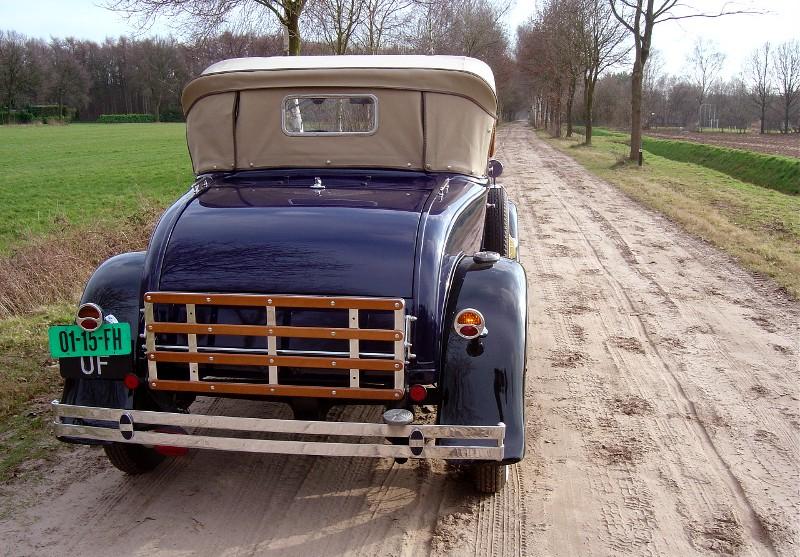

If somewhat claustrophobic club coupe motoring is not your cup of tea, but you enjoy the compact styling, there are alternatives.
Sitting among the plethora of manufacturers during the pre-Depression years are a series of convertible coupes, the Ford Model A being the most popular.
During its four-year run, the T’s replacement arrived in no less than five different drop-top two-door models – and one four-door model thrown in for good measure. Perhaps one of the simplest mass-produced automobiles to leave the assembly line, volumes have been written, and rewritten, about the Model A and how it came into being.
Each model shared the same basics throughout its life ; from its 103.5-inch wheelbase, to the completely redesigned – and slightly more superior to its predecessor – four-cylinder engine.
In fact, the same identical powertrain and drivetrain was installed under the coachwork of every Model A ever built.
Of the five drop-top models – Roadster, Deluxe Roadster, Deluxe Phaeton, Cabriolet and Convertible Sedan – the single most popular model was, and perhaps still is, our featured Roadsters.
Their high production numbers can be attributed to the fact that they were available all four years of the Model A’s lifespan and they boasted a low starting price – near $400 for the standard model.
By the summer of 1930 though, roadster production had declined sharply.
In an attempt to reverse the trend, Ford introduced the dressier Deluxe Roadster in August of 1930.
Though Model A aficionados group their beloved vehicles into two categories – 1928-’29 and 1930-’31 due to exterior design variations during the four-year run – Ford built well over 4 million examples in all their incarnations, meaning that they still can be easily found for sale at very affordable prices.
Model As in general are a smart buy as a distinguished, fun and easy-to-work-on collectible, despite the fact that the newest Model A is 80 years old !
Plenty of accessories were available to personalize these cars and many owners have customized their vehicles with sidemount spare wheels, spare-tire covers, cowl lamps and Motometer temperature gauges.
ENGINES &TRANSMISSIONS
The Model A featured a cast-iron, four-cylinder, L-head engine – the same engine that would be used throughout the car’s entire four-year production run.
With its 3.875×4.25-inch bore and stroke it had a low compression ratio of just 4.22:1.
With fuel being fed via gravity through a Zenith updraft carburetor, the compact 200.5-cu.in. engine cranked out 40hp at 2,200 rpm and 128-lbs.ft. of torque at 1,000 rpm, which made the car capable of reaching speeds beyond 50 mph.
Compared to the Model T, starting the Model A’s engine was far easier thanks to a more contemporary battery and ignition system that had replaced the old magneto ignition – though a hand crank was provided to buyers for emergency starting.
One subtle difference between the four model years is the packing nut on the water pump; it is cast brass – or bronze – on 1928-’29 engines.
Ford changed this nut to die-cast zinc for 1930-’31 engines.
Another change can be found in the Powerhouse generator.
A five-brush design was used until late 1928, and then changed to a three-brush Powerhouse used until mid-1929.
Most any home mechanic with good automotive knowledge, a readily available shop manual and basic hand tools, can keep the Model A engine cranking out the horsepower.
Relatively easy to maintain, the engine can be the most expensive – and laborious – part of a restoration.
Old babbitt bearings wear over time, necessitating the removal of the material from the block, then pouring and line boring new babbitt bearings, which itself is almost a lost art.
Replacing the planetary transmission that had been utilized on the Model T, the Model A features a three-speed, sliding-gear transmission.
The non-synchronized gearbox means that double clutching, coupled with slow and deliberate gear changes, prevents grinding.
The three speed was in place during the four-year run of the Model A, and is relatively easy to rebuild thanks to several specialists and parts suppliers.
Keeping up with modern traffic, especially on secondary roads and even an occasional jaunt on the highway, is made easier thanks to an overdrive for the transmission.
This popular modification drops the engine rpm and allows the compact roadster to cruise at speeds ranging from 60-65 mph.
REAR AXLE
An enclosed driveshaft transmits the power from the engine to the three-quarter floating rear axles.
The original final-drive ratio is 3.70:1 via spiral bevel gears.
Generally considered durable enough to handle the early roads, regular maintenance extends its longevity.
Several aftermarket final-drive ratios are available depending upon your individual needs ; from club touring to parade cruising.
Replacement driveshafts and axles are also available through several sources.
SUSPENSION
When it comes to the Model A’s suspension, not much had changed from the Model T.
Up front, there’s a solid I-beam axle and a single transverse semi-elliptical leaf spring.
In the rear, the solid axle is suspended via a semi-elliptical transverse leaf spring and Houdaille rotary hydraulic shocks.
It has been reported that Henry Ford drove the Model A prototype across a plowed field and upon his return asked for double-acting shocks.
Should you road test a Model A that isn’t riding up to your expectations there is hope.
One option is to have the existing shocks rebuilt.
The other option is to purchase brand-new reproduction units, should you find that the existing shocks are beyond repair.
During the first two years of production, Ford installed 21-inch welded wire wheels on the Model A.
To provide a lower stance on the 1930-’31 models, effectively helping alter the appearance of the Model A only slightly, Ford utilized 19-inch welded wire wheels.
New reproduction wire wheels are now available in both sizes.
BRAKES
Simple mechanical internal expanding drum brakes, which are rod-activated, are found on all four corners. With an 11-inch drum diameter, the total stopping area measures 225.5 square inches. The initial design called for the drum to be integral with the wire-wheel hub, however different wear rates, coupled with the potential difficulty of removing the wheel for a tire change, eliminated the design.
When the Model A was first introduced, a national highway system was a long time in arriving, meaning that its mechanical braking system was adequate for the then-current, and relatively low speeds. Anyone who has had the pleasure of trying to stop a 1920s-era vehicle in heavy traffic can tell you otherwise, especially when the brake bands get wet during that sudden summer shower. With an overall weight generally under 2,400 pounds — without passengers — even new linings and drums should provide ample stopping distance in dry weather. However it’s still a good idea to allow plenty of stopping distance.
BODY/FRAME
With the introduction of the Model A, Ford developed the use of steel as the structural material instead of wood.
The minimum amount of wood that was used in the body was solely there to provide a means for attaching interior trim.
This wood can and will rot, necessitating replacement.
Reproduction wood pieces are available new or can be easily made.
The steel body is mounted to a steel, ladder-type frame with three crossmembers.
The bolt-on fenders can be easily replaced, whereas other body panels require more effort.
Because these bodies were originally painted with fragile nitrocellulous lacquer, their exterior finishes easily chipped, causing rust to start.
Check the bottom of the fenders, doors and running boards for excessive rust.
But don’t be alarmed if the body is severely rusted as practically every body panel has been reproduced, making the restoration of Model A body shells a relatively easy exercise.
Although the 1928-’29 models feature a nickel-plated radiator shell as well as most of their brightwork, the 1930-’31 models feature stainless steel trim that is much longer lasting than the plated trim on the earlier models.
The bumpers for all four years were chrome plated.
Other subtle differences do exist between the 1928-’29 and 1930-’31 model years, such as a shorter grille and a more rounded hood and scuttle panel on the earlier bodies.
Like other drop tops, roadsters lack a permanent roof, effectively increasing the water damage potential. Another area of concern surrounds leaky fuel tanks in 1928-’30 models ; the common area being where the lower tank bracket holds the steering column.
The telltale sign is dark stains in this area.
INTERIOR
Basic is perhaps the only word to begin to describe the Model A’s interior appointments.
Three simple gauges – speedometer, fuel and ammeter – adorn the center of the dash, looking over the floor shifter.
The handbrake is of the squeeze-grip pull style and is located between the driver’s leg and the interior panel in front of the door.
In mid-1928 the handbrake was relocated in front of the shift lever and eventually by July of 1929, a bush-button lever was used, mounted to the right of the shift lever.
A dash lamp, ignition lock, hand-operated windshield wiper, side curtains and non-pleated artificial leather seats were all standard equipment.
Wind wings were a popular option, as well as a rumble seat for the occasional extra passenger or two and boot for the convertible top.
Electric windshield wipers were introduced as standard equipment in late 1928, replaced by vacuum wipers in June of 1930.
Safety glass was standard, and later models featured fold-down windshields for real open-air motoring.
While wind wings eventually became standard equipment, and the seats were liberated of their plain appearance, the plush Roadster Deluxe offered many of the optional features found on the base Roadster as standard equipment, including leather seats – a Ford first.
An easy way to differentiate the two models is by the top : the standard Roadster carries a black top, while the Deluxe models are tan.
More than one specialist offers reproduction trim, replacement tops and seat material – even interior kits – to bring your Model A interior back to life.
An assortment of parts can spice up a dull dash, including rebuilt speedometers and replacement lenses.
RESTORATION PARTS
Few cars afford the many possibilities to hobbyists who wish to restore them as the Model A does.
Virtually every aspect of the Model A has been, or is currently being, reproduced.
It’s not just limited to mechanical parts both small and large.
Body panels, gears, lamps and even suspension components are available through several parts suppliers, many of whom have been in the business since the mid-1960s.
A proliferation of national and local Model A clubs are a reliable wealth of information as well.
PARTS PRICES
Brake, front drum: $94
Brake lining set, two wheels: $30.95
Carburetor, rebuilt: $160
Connecting rod set, exchange only: $160
Engine gasket set: $46.95
Frame: $1,475
Flying Quail ornament: $55
Hub cap, stainless: $10.50 ea
Intake manifold: $82.50
Interior door panels: $190
Motometer wings, chrome: $20.25
Piston set, aluminum: $93
Quarter panel, left 1928-’29: $699
Radiator, 1930-’31: $530
Ring and pinion gear, high speed: $289
Seat frame: $67
Shock absorber: $89.50 ea
Top boot: $205
Wire wheel, 19-inch: $260
SPECIALISTS
Bratton’s Antique Auto Parts
800-255-1929
www.brattons.com
New mechanical and electrical parts, plus parts rebuilding service
Brassworks
805-544-8841
www.thebrassworks.net
New reproduction radiators
Brookville Roadster
937-833-4605
www.brookville-roadster.com
New steel body and chassis components
Egge Obsolete Engine Parts
866-534-EGGE
www.egge.com
New internal engine parts and gasket sets
Gaslight Auto Parts
937-652-2145
www.gaslightauto.com
New reproduction body, trim and mechanical parts
Gene Bunce
978-857-9130
www.BunceAParts.com
New reproduction windshield frames
LeBaron Bonney
800-221-5408
www.lebaronbonney.com
Reproduction upholstery kits, carpet sets and convertible tops
Mac’s Antique Auto Parts
877-470-1554
www.macsautoparts.com
New reproduction body, trim and mechanical parts
Mike’s “A” Ford-able Parts
706-652-3866
www.mikes-afordable.com
Reproduction wire wheels and new mechanical and body parts
M&S Hydraulics
800-646-1122
www.antiqueshockabsorbers.com
New and rebuilt shock absorbers
Sacramento Vintage Ford Parts
888-4-BANGER
www.vintageford.com
New reproduction body and trim parts and acessories
Smith and Jones
803-822-8500
www.modela-t-snj.com
New reproduction mechanical parts and accessories
Snyder’s Antique Auto Parts
888-262-5712
www.snydersantiqueauto.com
New reproduction body, trim and mechanical parts
Tam’s Model A Parts
508-835-9292
www.modelaparts.com
Reproduction parts and accessories
Varco
405-732-1637
www.varcoinc.com
Reproduction trunks and hardware
CLUB SCENE
Model A Ford Club of America
250 S. Cypress
La Habra, California 90631
562-697-2712
www.mafca.com
Dues: $30/year; Membership: 16,000
Model A Restorer’s Club
6721 Merriman Road
Garden City, Michigan 48135
734-427-9050
www.modelaford.org
Dues: $35/year; Membership: 10,000
PRODUCTION
Ford Model A Roadster (Standard)
1927: 269
1928: 81,937 *
1929: 191,529
1930: 112,901
1931: 5,499
Ford Model A Roadster (Deluxe)
1930: 11,318
1931: 52,997
* Includes 51,807 produced with rumble seat
WHAT TO PAY ?
LOW……….. AVERAGE… HIGH……… 1928 Roadster, two-passenger $20,000 $29,000 $40,000 1928 Roadster, four-passenger $18,000 $28,000 $36,000 1929 Roadster, two-passenger $20,000 $29,000 $40,000 1929 Roadster, four-passenger $19,000 $28,000 $40,000 1930 Roadster, two-passenger $23,000 $35,000 $49,000 1930 Roadster, four-passenger $23,000 $35,000 $50,000 1930 Roadster Deluxe, two-passenger $25,000 $35,000 $52,000 1930 Roadster Deluxe, four-passenger… $25,000 $35,000 $54,000 